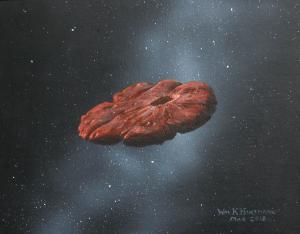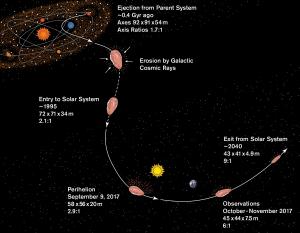Blog
Still Not Aliens
17 March 2021
 William Hartmann
William HartmannBack in 2017 astronomers observed a strange, comet-like object. From the trajectory of its orbit, this object couldn’t have originated in the outer regions of our solar system, as most comets do. This object must have come from interstellar space. Astronomers named it Oumuamua, from a Hawaiian word for “scout.” It is the first confirmed interstellar object to visit our solar system.
Oumuamua’s odd appearance and trajectory led a particular Harvard professor to declare it must have been an alien visitor, as in some kind of alien probe or spacecraft. He declared that anyone who disagreed is simply too closed-minded. He’s gotten a great deal of flack over this, because that’s not how science works. Oumuamua wasn’t made by aliens.
But Oumuamua is a strange object. It has a flattened shape, similar to the illustration above,1 and it lacked any visible coma or tail seen in comets. It was first thought to be an asteroid, but then its trajectory changed slightly, which would indicate some kind of cometary outgassing.
 S. Selkirk/ASU
S. Selkirk/ASUOumuamua is the only interstellar visitor we’ve observed. We have nothing to compare it with, so it’s hard to draw conclusions as to its nature. But recently two astronomers have published a couple of papers that cover what we know. The first is on the size and composition of Oumuamua,2 and the second is on how Oumuamua came to have its odd appearance.3
The first thing they noted is that Oumuamua’s brightness (albedo) and composition resembles that of Pluto. We know that Pluto has a surface of nitrogen ice, so this implies that Oumuamua has a similar nitrogen composition. Nitrogen ice evaporates easily when exposed to bright sunlight, so this would explain Oumuamua’s change in trajectory due to outgassing. Since the object didn’t develop a bright cometary coma and tail, this suggests it contained little water ice. This is again similar to parts of Pluto’s surface.
In the second paper, the team goes on to show that Oumuamua began as a fragment blasted from a Pluto-like planet in another solar system. Given its relative speed to our solar system, this likely occurred about 400 million years ago. They argue that Oumuamua didn’t originally have a pancake shape. Instead, Oumuamua gained this shape as it passed through the inner solar system. As a nitrogen body, it probably lost 95% of its mass during its visit to our solar system.
We will need to discover more interstellar visitors to confirm this theory, but that could happen when new telescopes such as Rubin Observatory are completed. If we’re right about Oumuamua, then it is the first evidence not of aliens, but Pluto-like worlds orbiting other stars.
Just as an aside, I really like William Hartmann’s portrayal of Oumuamua. It reminds me of old paintings seen in Astronomy and National Geographic. ↩︎
Alan P. Jackson & Steven J. Desch. “1I/‘Oumuamua as an N2 ice fragment of an exo‐Pluto surface: I. Size and Compositional Constraints.” Journal of Geophysical Research: Planets (2021). DOI: 10.1029/2020JE006706. ↩︎
S. J Desch & A. P Jackson. “1I/‘Oumuamua as an N2 ice fragment of an exo‐pluto surface II: Generation of N2 ice fragments and the origin of ‘Oumuamua.” Journal of Geophysical Research: Planets (2021). DOI: 10.1029/2020JE006807. ↩︎